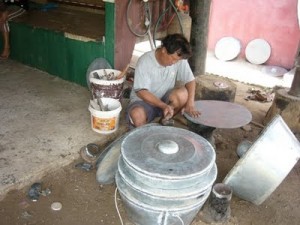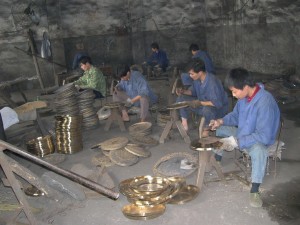Golden Bell vs. Iron T-Shirt
/ Hammering a Gong
Hammering a GongAt the recent Daoism Today conference in LA, in addition to presenting my unfinished paper, I did a participatory demonstration of many of the elements of Northern Shaolin, daoyin, taijiquan, and baguazhang which are theatrical, and appear to be connected to exorcistic rituals. Most of the responses were positive and encouraging. I did the demonstration on the first day of the 4 day conference so I had lots of time to respond to peoples comments and to hear suggestions. Zhou Xuanyun is a Daoist priest/monk who is married and lives in Boston. He describes himself as Zhengyi (Orthodox Unity) but he was trained on Wudang Shan which is a center of Quanzhen (Perfect Reality) monasticism and martial arts. His comment, which he made through an anthropologist, was that he didn't understand how I could practice both Daoist (taijiquan, baguazhang) and Buddhist (Shaolin) styles of practice simultaneously--wouldn't the training methods undermine each other?
My first response was that my first teacher's teacher, Kuo Lien-ying, practiced theater, Shaolin, taijiquan, and baguazhang. The anthropologists loved this answer because finding an actual person who embodied both traditions and saw no contradiction in practicing them both is their gold standard. The anthropologist view is that the continuity of culture is unbroken. To say continuity or tradition is broken is to apply some external idea of purity to a culture which never had it. So actual informants are king. I may not be doing them justice but I think that is the gist of their view. I tend to see the idea that Shaolin (Buddhist) and Taijiquan (Daoist) would need to be kept separate as a contemporary political contrivance. But I must add here that the anthropologists are doing a wonderful job of gathering detailed accounts of living and recently passed Daoists. This is fantastic stuff. (More on this in a future post.)
 Hammerng by hand
Hammerng by handZhou's challenge is still serious. He is right that the practices seem different and sometimes contradictory in methodology. Teaching a lot of Shaolin does disrupt my bagua and taiji practices. But I think this has less to do with method and more to do with the type of trance and energy expenditure necessary to teach kids classes. I might just as well ask, how can a person do Daoist practice in Boston? Isn't the chaos of urban America too much? I would hope that the answer is no, disruptions are not enough to negate strongly held commitments.
Historically speaking, I could spin this argument a lot of different ways but taking the time right now would be too much disruption of my own practice. Instead, I can make the argument simply and quickly.
One of the founders of the Boxer Rebellion (Yi He Quan) was a martial artist famous for his "Golden Bell" practice. This practice was said to be the original basis for what became the much derided Boxer Rebellion claim of invincibility to bullets. Golden Bell is still a common form of conditioning. The term conditioning here means a method of developing resistance to, or protection from, strikes to the body. It is a kind of toughness.
 Tuning a gong
Tuning a gongThe other common type of body conditioning is called "Iron T-Shirt." Golden Bell and Iron T-Shirt are good stand-ins for the larger argument between the internal practices of taiji and bagua on the one hand, and the external practices of Shaolin on the other; Golden Bell is internal, Iron T-Shirt is external.
The methodological difference between inner/outer or Shaolin/Wudang (Buddhist/Daoist) is resolved by looking at the convergence of these two practices. Iron T-Shirt is a process of rubbing, pounding, massaging, scraping and hitting the surface of the torso. Over time it makes one tougher and more resistant to strikes by thickening the surface, strengthening the bones, and desensitizing one to the shock of being struck. Over time the differentiation between outer toughness and inner softness becomes stronger and more prominent. At that point the process begins to reverse itself. The external surface becomes quiet while the inner softness becomes more lively. One no longer fears strikes to the surface because the differentiation of a lively, soft interior makes it is easy to move the vulnerable inner organs out of the way.
Golden Bell works by the opposite methodology. It starts from the inside. One relaxes and empties the torso of all tension, initially testing the torso for uniformity as a container of qi, like casting a bell, or tuning a gong. The density of the surface of the bell must be uniform, and the interior of the bell must be free of tension, imperfections or obstructions. Over time, the differentiation of inner liveliness and outer stillness becomes more distinct. Once this distinction is achieved it is tested the same way Iron T-Shirt begins, with rubbing, pounding and strikes to the torso. If the process has been completed correctly strikes to the quiet relaxed surface of the torso do not disturb the internal organs because they can be easily moved out of the way.
Learning martial arts, whether internal or external is always a disheveled process. No two teachers use exactly the same methods. External and internal methods are both defined by long lists of preliminary, basic, advanced, and extra-curricular experiments or exercises. Two different schools rarely produce the same fruition, regardless of whether they share the same "internal" or "external" designation.
I see the fruition of martial arts as a type of freedom. People are very nearly robots, our actions are usually predictable and automatic. Martial arts training, both internal and external, is a way to become unglued from our robot nature. Whether we call that robot "inner" or "outer" doesn't make a whole lot of difference.
(more on gongs, here and here)
